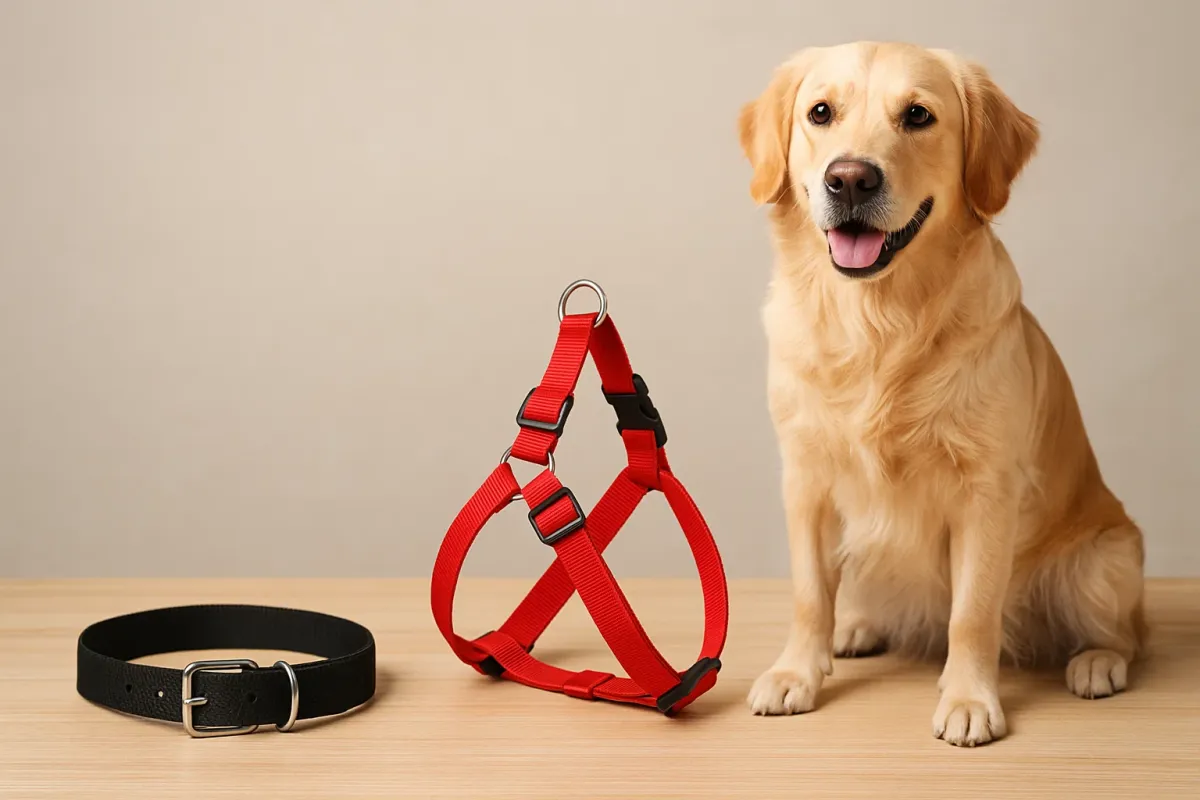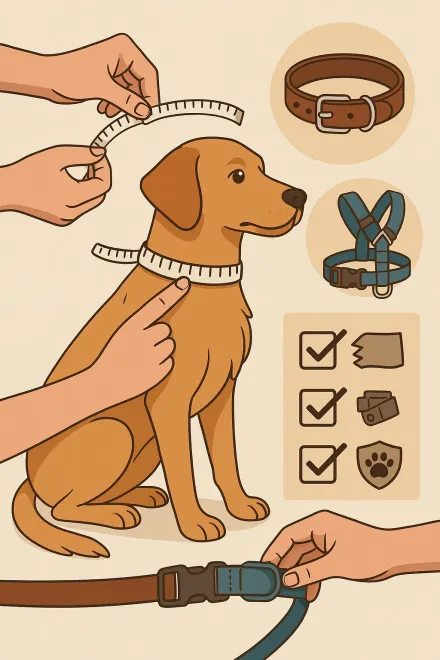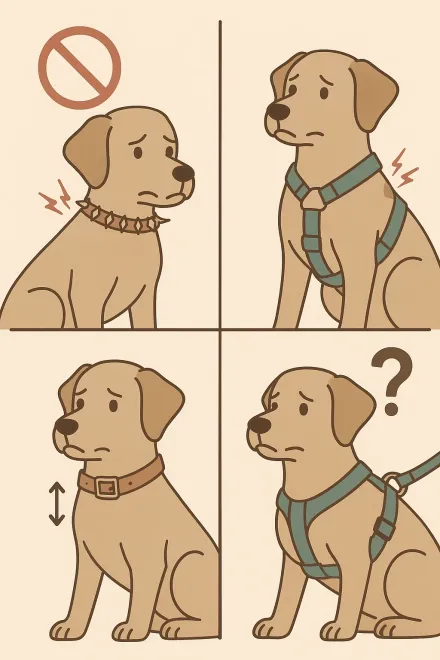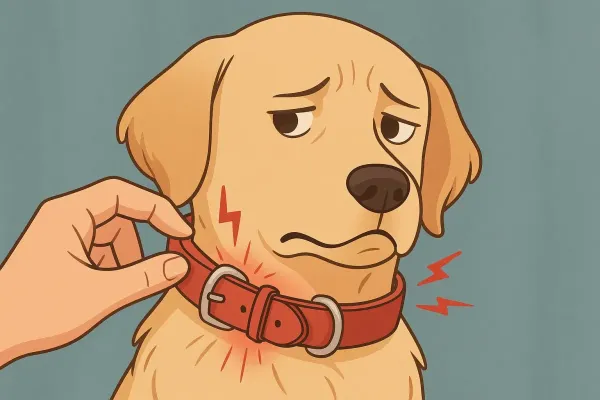
Last updated: October 6, 2025
Which is Better for Your Dog: Collar or Harness? A Complete Guide to Choosing Wisely

Choosing between a collar or harness for your dog is one of the most common questions among pet owners. Both accessories are useful and safe when used correctly, but each has specific characteristics that make it more suitable for certain dogs and situations.
In this article, we analyze the differences, advantages, and disadvantages of each option, along with practical tips to help you choose the best one based on your dog’s size, behavior, and health.
At the end, you’ll find a clear comparison that will help you decide whether a collar or harness is the right choice for your furry friend.
Differences Between Dog Collars and Harnesses
Before deciding which is better for your dog, it’s important to understand the differences between collars and harnesses, as each one has its own design, purpose, and benefits depending on the type of dog and activity.
A dog collar is a strap that fits around the neck and is mainly used to attach the leash and identification tag. There are several types of collars: leather — strong and durable; nylon — lightweight and comfortable; antiparasitic — protecting against fleas and ticks; or training collars — used to correct behavior, but only with caution and proper knowledge.
On the other hand, a dog harness fits around the chest and torso and distributes the pulling pressure more evenly. There are also various kinds: everyday walking harnesses — for daily comfort; no-pull harnesses — ideal for dogs that tend to pull; and sport harnesses — designed for running, hiking, or outdoor activities.
Generally, a collar is more suitable for calm and well-trained dogs since it’s quick to put on and convenient for daily use. A harness, however, is better for active dogs, puppies, or breeds with sensitive necks because it avoids pressure on the trachea and provides better control during walks.
Which is Better Depending on the Type of Dog
Not all dogs are the same, which is why the choice between a collar and a harness should depend on each dog’s size, strength, age, and health. While some dogs are comfortable with a traditional collar, others need the extra safety and even pressure distribution provided by a harness. Knowing your dog’s characteristics is key to choosing correctly and improving their daily well-being.
Below you’ll find a clear and simple guide to which option is usually best depending on the type of dog. This will help you avoid common mistakes and choose the safest and most comfortable accessory for your four-legged companion.
🐕 Small Dogs
Small or toy breeds have more fragile necks and delicate tracheas, so a harness is the safest option. It prevents pressure on the neck, reduces the risk of injury, and provides more comfort for long or urban walks.
🐾 Medium Dogs
For medium-sized dogs, it depends on behavior. If your dog is calm and doesn’t pull, a collar may be enough. But if they’re energetic or tend to pull, a no-pull harness is better as it distributes pressure evenly and gives the owner more control.
🦮 Large Dogs
Large dogs exert a lot of force when pulling, which can cause neck injuries with a collar. In these cases, a strong, padded harness is recommended — it offers better control, avoids strain, and improves safety during outdoor activities.
🐶 Puppies
During early growth stages, a harness is preferable since it protects the developing neck and helps teach leash manners without discomfort or bad experiences. It also supports positive training from the start.
😮💨 Dogs with Respiratory or Cervical Issues
For brachycephalic breeds or dogs with neck injuries, a harness is always the best choice. It avoids tracheal pressure, improves breathing, and makes walking easier — all essential for their overall health.
👴🐕 Senior Dogs
For older dogs or those with joint sensitivity, a padded ergonomic harness is generally recommended. It allows gentle handling and provides support for stairs or uneven ground, reducing discomfort and risk of injury.
In summary, while a collar remains practical in many situations, a harness provides greater safety, comfort, and control for most dogs — especially small, active, senior, or neck-sensitive ones. Assessing each case individually will help you choose the most suitable accessory and make walks more enjoyable for both you and your dog.
Collar or Harness Depending on the Activity
The choice between a collar and a harness doesn’t only depend on the type of dog but also on the activity you’re going to do together. A short city walk, a jog, or a car trip all require different levels of control, safety, and comfort. Choosing the right accessory for each situation enhances the experience and prevents injuries or bad habits.
1) Daily Walks
For everyday walks, a harness is usually the most comfortable and safest option, especially if your dog tends to pull or gets easily stimulated by the environment. It distributes pressure across the chest and torso, protecting the neck and trachea. If your dog is very calm and walks without tension, a lightweight, well-fitted collar can also work, provided you use a short, controlled leash.
2) Running or Sports
For running, canicross, or hiking, go for a sport harness with multiple adjustment points and padding in friction areas. This type of harness keeps the center of gravity stable, prevents neck strain, and allows smooth strides. Many models also include front and rear rings to adjust control based on terrain and training level.


3) Training
During training, it’s best to use a control or no-pull harness. It allows you to guide the dog’s movements with gentle cues, reduces neck tension, and facilitates positive reinforcement. Collars can be used in advanced stages when your dog reliably responds to basic commands (heel, stay, come). Avoid corrective or punishment collars unless supervised by a professional trainer, as they can cause stress and negative associations.
4) Traveling by Car
For car travel, the safest choice is a certified safety harness with a seatbelt or ISOFIX attachment, depending on the model. This setup minimizes the risk of injury during sudden stops or accidents and prevents the dog from moving freely around the vehicle. Collars should never be used as an anchor point, as they concentrate force on the neck.
5) City vs. Countryside Walks
City: In urban environments with traffic or crowds, a harness provides better control and reduces sudden pulls caused by reactions to bikes, other dogs, or noises. A model with a top handle can help you hold your dog securely in unexpected situations.
Countryside: In open areas or nature trails, a durable harness remains the most versatile option for stability and safety. If your dog is very well trained and walks calmly by your side, a strong collar may be sufficient — but always use a leash compliant with local regulations and ensure good visibility if walking at dusk.
Conclusion: Match the accessory to the activity. In most scenarios, a harness wins for safety, ergonomics, and control; a collar can still work for calm dogs on relaxed walks. Choosing the right one for each context enhances your dog’s well-being and the quality of your outings together.

Tips for Choosing the Right One
Before deciding on a collar or harness, it’s essential to consider a few practical details that make a big difference in your dog’s comfort and safety. A poorly chosen accessory can cause chafing, discomfort, or even injuries — so it’s worth following a few key guidelines.
- Measure the neck or chest correctly: Use a flexible tape measure and leave a two-finger gap between the accessory and the skin. A model that’s too tight can cause discomfort, while one that’s too loose may allow escapes.
- Choose good materials: Nylon is lightweight and durable; leather provides strength and elegance; and neoprene offers softness and comfort. Avoid rigid materials or poorly finished seams that can irritate the skin.
- Check the fit: Make sure the buckles and fastenings are secure but easy to fasten. For harnesses, ensure it doesn’t twist or ride up toward the neck when your dog walks or pulls.
- Prioritize comfort and safety: The accessory should match its purpose — daily walks, training, or sports. A comfortable, well-fitted dog will be calmer and more responsive during outings.
Taking a few minutes to measure, adjust, and compare materials is the best way to ensure your dog enjoys every walk safely and comfortably.
Common Mistakes When Using Collars or Harnesses
Although using a collar or harness seems simple, there are frequent mistakes that can affect your dog’s safety and comfort. Recognizing them early helps you avoid issues and enjoy safer, more pleasant walks.
- Using punishment collars without proper knowledge: Prong, electric, or choke collars can cause pain and fear if used incorrectly. They should only be used under the supervision of a professional trainer.
- Not checking if the harness rubs or pinches: Movement can cause certain parts of the harness to rub or create pressure points. Check the fit regularly, especially for short-haired or sensitive-skinned dogs.
- Not adjusting as the dog grows: Puppies grow quickly, and a once-perfect accessory can become tight or restrictive. Adjust or change the size as needed.
- Choosing the wrong size or type: A collar that’s too narrow or a poorly designed harness can alter your dog’s natural posture and cause discomfort when walking. It’s best to test the product before buying or follow the manufacturer’s size guide.
Avoiding these mistakes and checking your dog’s collar or harness regularly ensures safer, more comfortable, and healthier walks for both you and your pet.

Conclusion
There’s no universal answer when choosing between a collar or a harness. Every dog is different — their size, strength, age, energy level, and health all play a role in determining which option is best. The key is to observe your dog’s behavior, prioritize their comfort, and adapt the accessory to the activities you do together.
While collars are practical for calm and well-trained dogs, harnesses generally offer greater control and safety, especially for puppies, small breeds, or dogs with neck or respiratory issues.
Ultimately, it’s not about choosing one over the other but finding the balance that best fits your dog’s needs and your lifestyle. The important thing isn’t whether you use a collar or a harness — it’s choosing the one that best suits the health, size, and temperament of your four-legged friend.
Frequently Asked Questions About Dog Collars and Harnesses
Which is better for walking my dog — a collar or a harness?
It depends on your dog’s size, strength, and behavior. In general, a harness is more suitable for dogs that pull, are small, or have respiratory issues, while a collar works well for calm, well-trained dogs.
Does a harness stop a dog from pulling on the leash?
Some designs, such as no-pull harnesses, are made to reduce pulling and improve leash control. However, consistent training and patience are just as important to correct this behavior.
Can I leave the collar or harness on all day?
It’s not recommended to leave either accessory on permanently. Ideally, remove them at home to prevent chafing or discomfort, especially when your dog sleeps or rests frequently.
Is a harness more comfortable than a collar?
Yes. In most cases, a harness distributes pressure more evenly and prevents neck injuries. It’s also more comfortable for long walks, sports activities, or dogs with sensitive builds.
Are there breeds that shouldn’t wear collars?
Yes. Brachycephalic breeds such as French Bulldogs, Pugs, and other flat-faced dogs, as well as those with neck or respiratory problems, should always wear a harness to avoid tracheal pressure.
What type of harness is best for a puppy?
A lightweight, padded, and adjustable harness is best for puppies. It allows free movement without straining their neck and helps them learn to walk on a leash comfortably from a young age.
What about large or strong dogs?
For large or muscular dogs, choose a heavy-duty or sport harness with reinforced straps and metal rings. It provides better control and prevents the dog from escaping or getting injured during walks.
Can I use both a collar and a harness at the same time?
Yes, many owners do. For example, you can use the harness for the leash and the collar for the ID tag only. Just make sure neither is too tight or uncomfortable.
Which option is safest for car travel?
For car trips, a certified safety harness is the most recommended option. It attaches directly to the seat belt system and prevents injuries in case of sudden braking or accidents.
Which lasts longer — a collar or a harness?
It depends on the material and usage, but in general, leather or nylon collars tend to be more durable. Harnesses, with their multiple straps and stitching points, may require a bit more maintenance over time.


